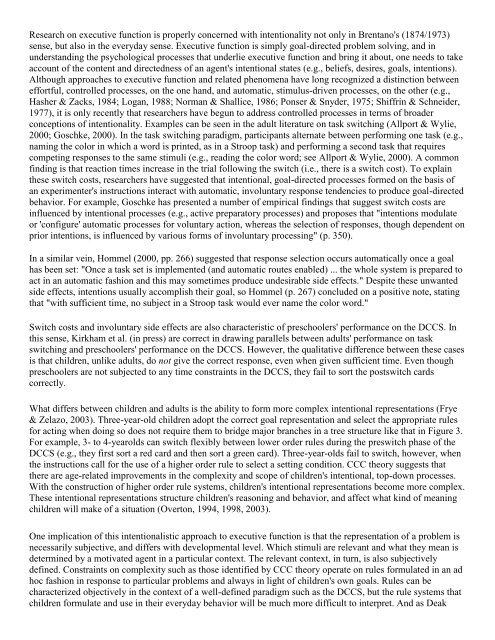THE DEVELOPMENT OF EXECUTIVE FUNCTION IN EARLY ...
THE DEVELOPMENT OF EXECUTIVE FUNCTION IN EARLY ...
THE DEVELOPMENT OF EXECUTIVE FUNCTION IN EARLY ...
Create successful ePaper yourself
Turn your PDF publications into a flip-book with our unique Google optimized e-Paper software.
Research on executive function is properly concerned with intentionality not only in Brentano's (1874/1973)<br />
sense, but also in the everyday sense. Executive function is simply goal-directed problem solving, and in<br />
understanding the psychological processes that underlie executive function and bring it about, one needs to take<br />
account of the content and directedness of an agent's intentional states (e.g., beliefs, desires, goals, intentions).<br />
Although approaches to executive function and related phenomena have long recognized a distinction between<br />
effortful, controlled processes, on the one hand, and automatic, stimulus-driven processes, on the other (e.g.,<br />
Hasher & Zacks, 1984; Logan, 1988; Norman & Shallice, 1986; Ponser & Snyder, 1975; Shiffrin & Schneider,<br />
1977), it is only recently that researchers have begun to address controlled processes in terms of broader<br />
conceptions of intentionality. Examples can be seen in the adult literature on task switching (Allport & Wylie,<br />
2000; Goschke, 2000). In the task switching paradigm, participants alternate between performing one task (e.g.,<br />
naming the color in which a word is printed, as in a Stroop task) and performing a second task that requires<br />
competing responses to the same stimuli (e.g., reading the color word; see Allport & Wylie, 2000). A common<br />
finding is that reaction times increase in the trial following the switch (i.e., there is a switch cost). To explain<br />
these switch costs, researchers have suggested that intentional, goal-directed processes formed on the basis of<br />
an experimenter's instructions interact with automatic, involuntary response tendencies to produce goal-directed<br />
behavior. For example, Goschke has presented a number of empirical findings that suggest switch costs are<br />
influenced by intentional processes (e.g., active preparatory processes) and proposes that "intentions modulate<br />
or 'configure' automatic processes for voluntary action, whereas the selection of responses, though dependent on<br />
prior intentions, is influenced by various forms of involuntary processing" (p. 350).<br />
In a similar vein, Hommel (2000, pp. 266) suggested that response selection occurs automatically once a goal<br />
has been set: "Once a task set is implemented (and automatic routes enabled) ... the whole system is prepared to<br />
act in an automatic fashion and this may sometimes produce undesirable side effects." Despite these unwanted<br />
side effects, intentions usually accomplish their goal, so Hommel (p. 267) concluded on a positive note, stating<br />
that "with sufficient time, no subject in a Stroop task would ever name the color word."<br />
Switch costs and involuntary side effects are also characteristic of preschoolers' performance on the DCCS. In<br />
this sense, Kirkham et al. (in press) are correct in drawing parallels between adults' performance on task<br />
switching and preschoolers' performance on the DCCS. However, the qualitative difference between these cases<br />
is that children, unlike adults, do not give the correct response, even when given sufficient time. Even though<br />
preschoolers are not subjected to any time constraints in the DCCS, they fail to sort the postswitch cards<br />
correctly.<br />
What differs between children and adults is the ability to form more complex intentional representations (Frye<br />
& Zelazo, 2003). Three-year-old children adopt the correct goal representation and select the appropriate rules<br />
for acting when doing so does not require them to bridge major branches in a tree structure like that in Figure 3.<br />
For example, 3- to 4-yearolds can switch flexibly between lower order rules during the preswitch phase of the<br />
DCCS (e.g., they first sort a red card and then sort a green card). Three-year-olds fail to switch, however, when<br />
the instructions call for the use of a higher order rule to select a setting condition. CCC theory suggests that<br />
there are age-related improvements in the complexity and scope of children's intentional, top-down processes.<br />
With the construction of higher order rule systems, children's intentional representations become more complex.<br />
These intentional representations structure children's reasoning and behavior, and affect what kind of meaning<br />
children will make of a situation (Overton, 1994, 1998, 2003).<br />
One implication of this intentionalistic approach to executive function is that the representation of a problem is<br />
necessarily subjective, and differs with developmental level. Which stimuli are relevant and what they mean is<br />
determined by a motivated agent in a particular context. The relevant context, in turn, is also subjectively<br />
defined. Constraints on complexity such as those identified by CCC theory operate on rules formulated in an ad<br />
hoc fashion in response to particular problems and always in light of children's own goals. Rules can be<br />
characterized objectively in the context of a well-defined paradigm such as the DCCS, but the rule systems that<br />
children formulate and use in their everyday behavior will be much more difficult to interpret. And as Deak
















